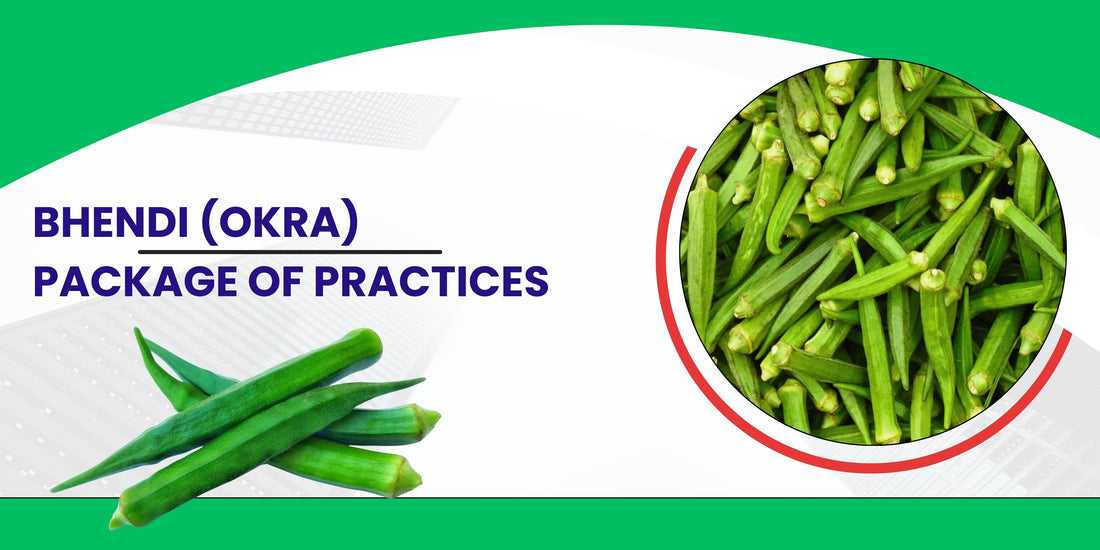
BHENDI PACKAGE OF PRACTICES
Scientific Name: Ablemoschus esculantus
Family: Malvaceae
Introduction:
Bhendi, commonly referred to as lady's finger or okra, is a popular vegetable crop that is grown extensively in tropical and subtropical climates. It is valued for its soft, tasty green pods and is part of the Malvaceae family. Originally from Africa, bhendi is now widely grown in nations like India and is a vital part of both agriculture and nutrition.
The crop has nutritional significance because it is a high source of calcium, iron, vitamins A, B, and C, as well as dietary fiber.
Because of its rapid returns, farmers prefer bhendi, a crop with a short growing season. It needs well-drained loamy soils with a pH of 6-7 and temperatures between 25 and 35°C for optimal growth. It is a profitable crop due to its demand, high yield potential, and adaptability.
Climate
Bhendi requires long warm growing season during its growing period. It gives good yield in warm humid condition. It grows best within a temperature range of 24-27°C. It can be successfully grown in rainy season even in heavy rainfall area. Bhendi is highly susceptible to frost injury. Seeds fail to germinate when temperature is below 20o C.
Soil
Okra can be cultivated in wide range of soil. The ideal soil for okra cultivation is sandy loam to clay loam with rich organic matter and better drainage facility. If proper drainage is available it can grow well in heavy soils. The pH of soil should be 6.0 to 6.5. Do not cultivate crop in alkaline, saline soils also in poor drainage capacity soils.
Seed rate and seed treatment
Bhendi requires about 3.5-5.5 kg seeds/ha during summer seasons and 8-10 kg seeds/ha for rainy season crop. The seed rate generally varies with germination percentage, spacing and season. Before sowing the seeds are soaked in a solution of Bavistin (0.2%) for 6 hours. The seeds are then dried in shade.
Land preparation
The land should be well prepared with 2-3 ploughing. Well decomposed FYM (25 t/ha) is incorporated at the time of land preparation. Bhendi is sown on ridges or on flat soil. If soil is heavy, sowing should be done on ridges. Application of organic manure like neem cake and poultry manures improves the plant growth and the yield in this crop. It is possible to reduce the use fertilizer by using neem cake and poultry manures.
Sowing
Sow three seeds per hill at 30 cm apart and then thin to 2 plants per hill after 10 days.
Spacing
Seeds are sown at a spacing of 45 x 30 cm.
Manure and fertilizers
10-15 t/ha of FYM should be mixed with the soil 15-12 days before sowing. 50: 50: 50 kg: P: K is required for a hectare of land. One-third dose of N along with full P & K are applied at the time of final land preparation. Remaining N should be applied at 30 and 60 days after sowing.
Irrigation
Irrigation frequency in bhendi crop varies with the season and the soil type. Bhendi is grown without irrigation in rainy season in high rainfall area where distribution of rainfall is uniform throughout the growing season. A light irrigation is given soon after seed sowing to ensure good germination. The crop is irrigated at an interval of 4-5 days in summer. Moisture stress at fruit setting stage reduces the fruit quality and the yield. Normally the crop is irrigated by adopting the furrow method of irrigation
Intercultural Operations
Weed control
Weeding is done to control the growth of weeds in okra. Earthing up in the rows should be done in rainy season crop.
Spray Oxyflourfen at 0.15 kg a.i./ha or Fluchloralin at 1.0 kg a.i./ha or Metolachlor at 0.75 kg a.i./ha as pre emergence application on third day after sowing. Herbicide application should be integrated with one hand weeding on 30 days after sowing.
Harvesting and Yield
The fruits are ready for harvest in about 45-60 days after seed sowing depending upon variety and season. Size of the pod and stage at which it is harvested varies with variety/hybrid and market preference. Frequent picking promotes fruit development and prevents the pods from growing too large.
Yield of the Bhendi varies greatly depending upon variety and season of cultivation. On an average bhendi yields 7.5-10 t/ha while the yield of hybrid varieties ranges from 15-22 t/ha.
